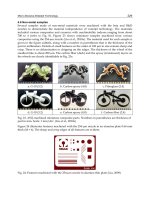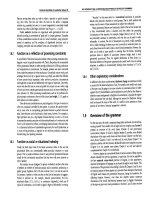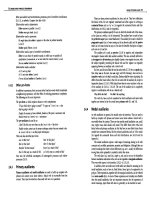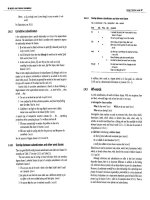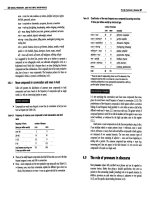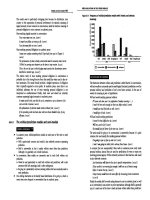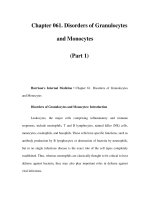Chapter 109. Disorders of Platelets and Vessel Wall (Part 8) potx
Bạn đang xem bản rút gọn của tài liệu. Xem và tải ngay bản đầy đủ của tài liệu tại đây (13.41 KB, 5 trang )
Chapter 109. Disorders of Platelets
and Vessel Wall
(Part 8)
Hemolytic Uremic Syndrome
HUS is a syndrome characterized by acute renal failure, microangiopathic
hemolytic anemia, and thrombocytopenia. It is seen predominantly in children and
in most cases is preceded by an episode of diarrhea, often hemorrhagic in nature.
Escherichia coli O157:H7 is the most frequent, although not only, etiologic
serotype. HUS not associated with diarrhea (termed DHUS) is more heterogeneous
in presentation and course. Some children who develop DHUS have been found to
have mutations in genes encoding Factor H, a soluble complement regulator, and
membrane cofactor protein that is mainly expressed in the kidney.
Hemolytic Uremic Syndrome: Treatment
Treatment of HUS is primarily supportive. In D+HUS, many (~40%)
children require at least some period of support with dialysis; however, the overall
mortality is <5%. In D–HUS the mortality is higher, approximately 26%. Plasma
infusion or plasma exchange has not been shown to alter the overall course.
ADAMTS13 levels are generally reported to be normal in HUS, although
occasionally they have been reported to be decreased. As ADAMTS13 assays
improve, they may help in defining a subset that better fits a TTP diagnosis and
may respond to plasma exchange.
Thrombocytosis
Thrombocytosis is almost always due to (1) iron deficiency; (2)
inflammation, cancer, or infection (reactive thrombocytosis); or (3) an underlying
myeloproliferative process [essential thrombocythemia or polycythemia vera
(Chap. 103)] or, rarely, the 5q-myelodysplastic process (Chap. 102). Patients
presenting with an elevated platelet count should be evaluated for underlying
inflammation or malignancy, and iron deficiency should be ruled out.
Thrombocytosis in response to acute or chronic inflammation has not been
associated with an increased thrombotic risk. In fact, patients with markedly
elevated platelet counts (>1.5 million), usually seen in the setting of a
myeloproliferative disorder, have an increased risk of bleeding. This appears to be
due, at least in part, to acquired von Willebrand disease (vWD) due to platelet-
vWF adhesion and removal.
Qualitative Disorders of Platelet Function
Inherited Disorders of Platelet Function
Inherited platelet function disorders are thought to be relatively rare,
although the prevalence of mild disorders of platelet function is unclear, in part
because our testing for such disorders is suboptimal. Rare qualitative disorders
include the autosomal recessive disorders Glanzmann's thrombasthenia (absence
of the platelet GpIIbIIIa receptor) and Bernard Soulier syndrome (absence of the
platelet GpIb-IX-V receptor). Both are inherited in an autosomal recessive fashion
and present with bleeding symptoms in childhood.
Platelet storage pool disorder (SPD) is the classic autosomal dominant
qualitative platelet disorder. This results from abnormalities of platelet granule
formation. It is also seen as a part of inherited disorders of granule formation, such
as Hermansky-Pudlak syndrome. Bleeding symptoms in SPD are variable but
often mild. The most common inherited disorders of platelet function are disorders
that prevent normal secretion of granule content. Few of the abnormalities have
been dissected at the molecular level, but these are likely due to multiple
abnormalities. They are usually described as secretion defects. Bleeding symptoms
are usually mild in nature.
Inherited Disorders of Platelet Dysfunction: Treatment
Bleeding symptoms or prevention of bleeding in patients with severe
dysfunction frequently requires platelet transfusion. Care is taken to limit the risk
of alloimmunization by limiting exposure and using prestorage leukodepleted
platelets for transfusion. Platelet disorders associated with milder bleeding
symptoms frequently respond to desmopressin [1-deamino-8-D-
arginine vasopressin (DDAVP)]. DDAVP increases plasma vWF and FVIII levels;
whether it also has a direct effect on platelet function is unknown. Particularly for
mucosal bleeding symptoms, antifibrinolytic therapy (epsilon-aminocaproic acid
or tranexamic acid) is used alone or in conjunction with DDAVP or platelet
therapy.
Acquired Disorders of Platelet Function
Acquired platelet dysfunction is common, usually due to medications,
either intentionally, as with antiplatelet therapy, or unintentionally, as with high
dose penicillins. Acquired platelet dysfunction occurs in uremia. This is likely
multifactorial, but the resultant effect is defective adhesion and activation. The
platelet defect is improved most by dialysis, but may also be improved by
increasing the hematocrit to 27–32%, giving DDAVP (0.3 µg/kg), or use of
conjugated estrogens. Platelet dysfunction also occurs with cardiopulmonary
bypass due to the effect of the artificial circuit on platelets, and bleeding
symptoms respond to platelet transfusion. Platelet dysfunction seen with
underlying hematologic disorders can result from nonspecific interference by
circulating paraproteins or intrinsic platelet defects in myeloproliferative and
myelodysplastic syndromes.
